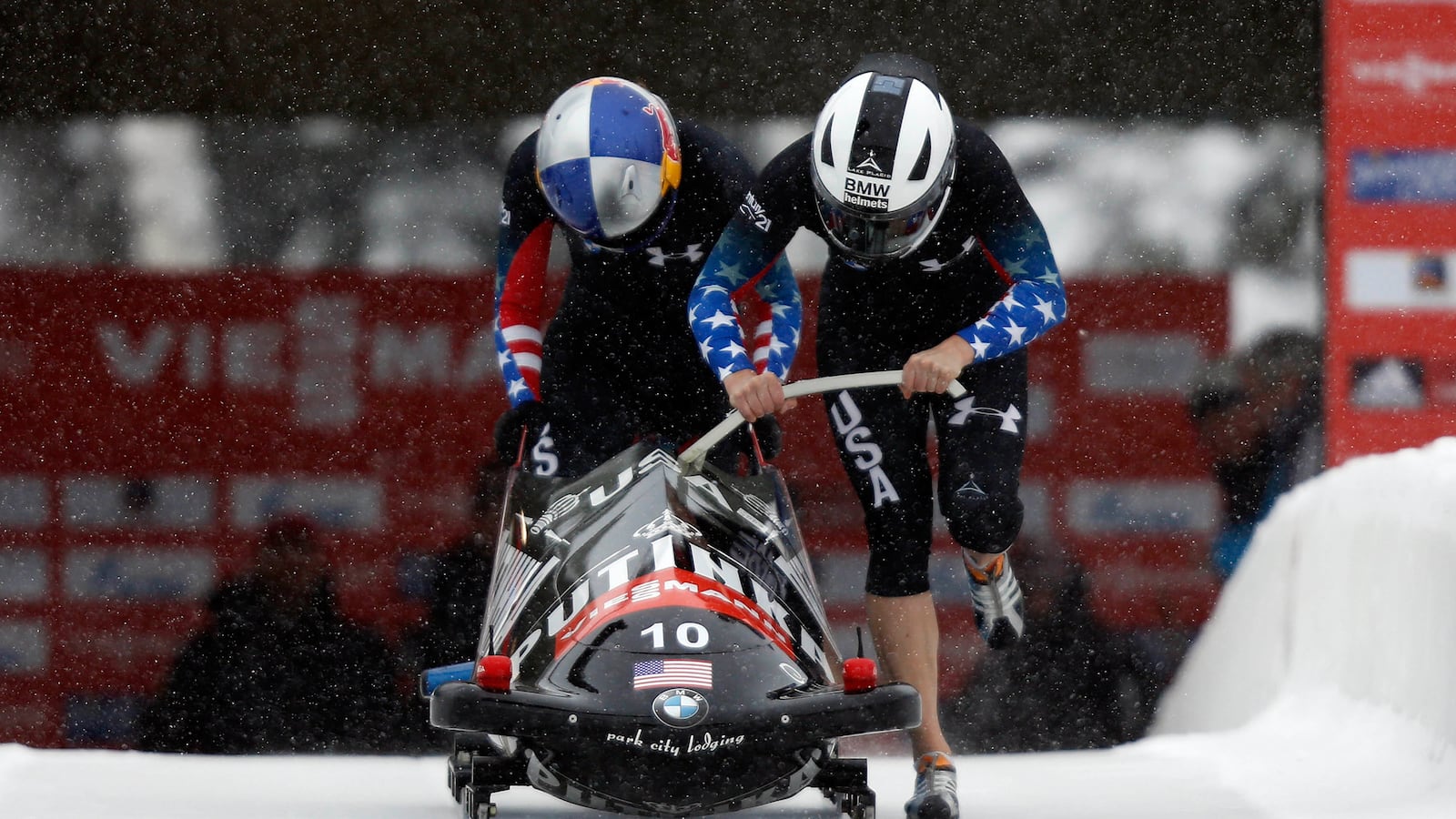Bobsledders, lugers, and skeleton athletes cruise down an icy track, in some cases with their faces just inches from the frozen surface, at upwards of 100 miles an hour. But a la the premise often inferred by Disney's Cool Runnings, can anybody do it?
American track and field stars Lolo Jones and Lauryn Williams, who are trying to lock down spots on the bobsled team for the upcoming Winter Olympics, will learn their fates for Sochi in just a couple days. Regardless of the outcome, after only a year of training and competing, both—Jones, a two-time Olympic hurdler, and Williams, the 100-meter silver medalist at the 2004 Games in Athens and member of the 2012 4x100 relay team that took gold in London—are making a strong case for being named to the team.
The two are not nearly the first athletes from another sport who attempted to transition to this favorite event, also referred to as bobsleigh, of the Winter Games. Former college and pro football standout Herschel Walker is probably the most well known athlete to crossover and give bobsled a shot. In 1992 during the NFL offseason, after only briefly training and having never before tried the sport, the Heisman Trophy winner a decade earlier took seventh in Albertville, France.
Granted, all three are obviously world-class athletes, but what does it say about bobsled—or all of the sliding sports for that matter—if in such a short period of preparation time each can either have a legitimate chance of competing at the world's top international competition or performing highly once there?

"I don't think it says anything about the sport, because the sport is tough," Jones told me before the start of this season's qualification process. "I think that's what I don't like, the fact that people will be like, 'Oh, it must be that bobsled is untalented if Lolo can come in and just be one of the top bobsledders in one year.' But they forget that I'm one of the best Americans for track and field. It's not like you're just picking a college or high school athlete off the street. You're picking one of the best athletes to come in and push a bobsled."
It begs the question, however, is it easy? And how would other candidates, perhaps even the average person, do in competition if given the chance? Could they maybe even make it to the Olympics?
***
In fact, almost all American bobsledders are converted athletes and don't pick up the sport until later in their athletic careers. The members of the defending Olympic champion U.S. men's four-man team—commonly known as the Night Train because of its notorious primer black sled—which became the first American team to win a medal in more than 50 years when it took gold in Vancouver in 2010, all transitioned from other sports.
Steve Holcomb, considered one of the best drivers in the world, was previously a national-level alpine skier. The pushers on the team consisted of Steve Mesler, a former track star at the University of Florida, and then Justin Olsen and Curt Tomasevicz, both former college football players, at the Air Force Academy and University of Nebraska, respectively.
"Honestly, there aren't a lot of secrets," Tomasevicz acknowledged recently. "It's push the sled as fast as you can. That's the bottom line."
Then really, how hard could it be?
"Definitely not easy," responded Tomasevicz, now in his tenth season sliding, and heading to his third Olympic Games. "I always say that bobsled is a simple idea with a lot of complicated details. Anybody can push a merry-go-round, or push their buddy on sled down a hill. But pushing a sled fast with great technique is a complicated thing to do where you're not wasting any energy."
Still, it hasn't stopped plenty of other renowned athletes from trying their hand. Apart from Herschel Walker, the registry has included several other football players, with wide receiver Willie Gault, who was an alternate in 1988 in Calgary and is possibly best known for his role with the '85 Chicago Bears—as lead singer of the "Super Bowl Shuffle"—as the most widely remembered. Joe Sawyer (University of Colorado), Greg Harrell (University of Maryland) and two Oklahoma Sooners, Aubrey Jones and Mike Aljoe are others who transitioned successfully.
It goes the other direction, too, where established bobsledders recruit elite performers to don a cold weather suit, especially in the wake of Jones and Williams's degree of quality results to this point. Holcomb is a leading pitchman, and is always on the lookout for talent in unexpected places.
"I did ask Ashton Eaton to come out," the driver of USA-1 said of the 2012 Olympic decathlon gold medalist, who declined. "It kind of died right there, but that would have been cool. I think, realistically, it all comes down to performance. I'm looking for the fastest push. If Brad Pitt could push me into a gold medal, then awesome, but I don't think he can. He's what, 50 years old? Might be a little old for bobsled. But, I mean, I'm just looking for numbers. If you're not famous now, we'll push fast, win a gold medal and make you famous."
There are also certainly examples among skeleton and luge of supreme achievement, limited experience notwithstanding.
American skeleton athlete Katie Uhlaender, who is working toward vying for an Olympic medal for the third time in February, is Exhibit A. The daughter of former Major Leaguer Ted Uhlaender, she fondly recalls her fortuitous introduction to the sport, which is essentially a headfirst sled race down the ice-covered sheet. Despite beginning the sport at 19 years old, results came quickly. After by chance meeting a bobsledder at a local rec. center in 2003 when she challenged a girl she had just met to a foot race, Uhlaender was talked into trying skeleton.
"From the first time I tried the sport to my eighth week, I became national champion," the now 29-year-old says. "I was junior national champion after my third week, got seventh in junior world championships, and my eighth week ever sliding, I won nationals."
Like the list of bobsledders, though, Uhlaender grew up an all-around athlete. Aside from her late father, her mother Karen, who has been an aggressive skier in Colorado where Katie was raised for many years, helped her along. Katie sampled just about everything, herself skiing, before running track, powerlifting, playing baseball and basketball and golfing in high school, and finally briefly skiing freestyle and racing.
"If you weren't an athlete, you weren't cool," she said. "Pretty much any sport I had the opportunity to do, I did, and my father and mother had a large part to do in that. If I had been a boy I'd be a Major League Baseball player, but unfortunately I'm 5'3" and female, so my options are much more limited, being a woman. So I lucked out and I got to go sledding for my career."
Uhlaender, now a two-time World Cup skeleton champion, the reigning world champion and the top-ranked American at No. 2 in the world, truly may be that special. She even nearly qualified for the Summer Games held in London in 2012 as a weightlifter, just missing the cut. She's already considering another attempt for Rio de Jainero, Brazil in 2016.
In the meantime, for those with a genuine interest in joining the sliding ranks, the process might be more straightforward than one would presume.
***
American participation numbers for bobsled, for instance, actually point to a fairly good possibility of competing at the national or even international level. In the entirety of the United States, there are fewer than 300 active registered members, per the sport's national governing body. In Lake Placid, N.Y., where the U.S. Bobsled and Skeleton Federation (USBSF) is based—and from 1930 until 1997, the only bobsled track in the nation—that total includes just 40 participants between the ages of 12 and 18 years old. And in Park City, Utah, the other location in the country where someone can practice the sport after a track opened there in preparation for the 2002 Winter Games, just six athletes. Six.
The reality of training for the sliding sports, or for that matter even familiarity with them, really comes down to geography.
Beyond the passenger ride program offered in both Lake Placid or Park City, where those who wish to shoot down the same track as the Olympians in tow with the pros—think skydiving with an expert fastened to your back—but much lower down to avoid top speeds, the USBSF recruits on its website. After submitting a résumé, coaches contact qualified applicants for a combine test conducted annually in the spring and summer. From there, the cream of the crop is invited to attend schools or push championships and team trials, and then who knows, the Olympics?
It's that simple—quite a bit easier than, say, obtaining a tryout for the NFL—though, by the percentages, actually breaking through is probably on par. American luge has been granted 10 total spots in Sochi; skeleton five total with three going to men and two to women; and in bobsled, two four-man teams, two men's teams in two-man, and three two-woman teams. That means Lolo Jones and Lauryn Williams are battling with three other women for just three open slots.
Men's four-man has been contested since it debuted in the very first Winter Olympics in Chamonix, France in 1924, with two-man added in 1932, and two-woman finally introduced to the Games in 2002 in Salt Lake City. Four-woman is not an event. And for as long as the list is of athletes who have transitioned to compete in the Olympics, the one that includes those who have tried, but didn't necessarily succeed into their foray on the ice track is even more crowded.
Gault, for example, did qualify as an alternate in 1988, but didn't compete, and then missed the team in '92 in Albertville. Also, two former world-record holder hurdlers Renaldo Nehemiah and Roger Kingdom both failed in their bids for the Albertville Games. The big names go on and on. And notably, that first group of Jamaican bobsledders from 1988, the two-man team placed 30th and in four-man, they were the only country to crash and not finish.
"It's not an easy thing to do," reiterated Tomasevicz, who hopes to repeat gold in four-man in Sochi. "It takes strength, power, speed and a lot of body awareness. The idea is get from Point A to Point B, hit it as hard as you can," he says as he smacks his fist into his open palm, "just gut it out, brute strength. But in fact, it takes a lot of body awareness to control how your toes come up after each push, or not be shaking your head when you're pushing the sled, or controlling every part of your body while you're going 100 percent."
With Lolo Jones and Lauryn Williams awaiting the final news on their roles with the American women's team, should either or both make it to Sochi, the conclusions about sliding sports will continue.
"I knew it would be hard, but it was definitely difficult, for sure," Jones said of her segue from track to bobsled. "I didn't think it would be this hard, absolutely. And I will say this, I wasn't the best. I was good at running, but my technique wasn't that good. I think a lot of people assume that it's easier. It's just a misconception about bobsled that it's a sport that you can just come in and be dominant."






